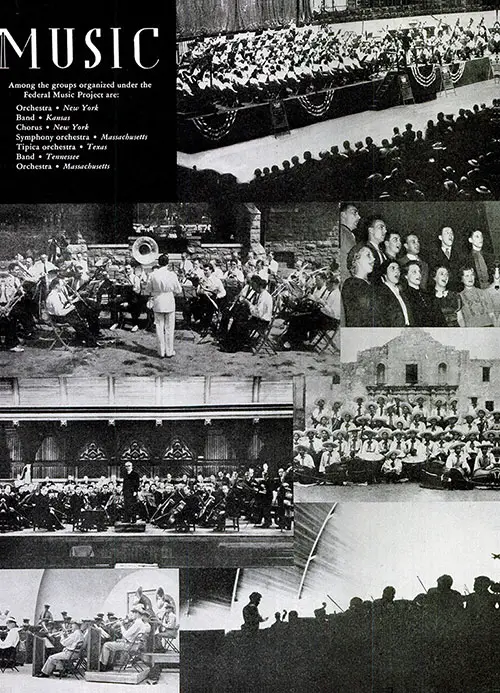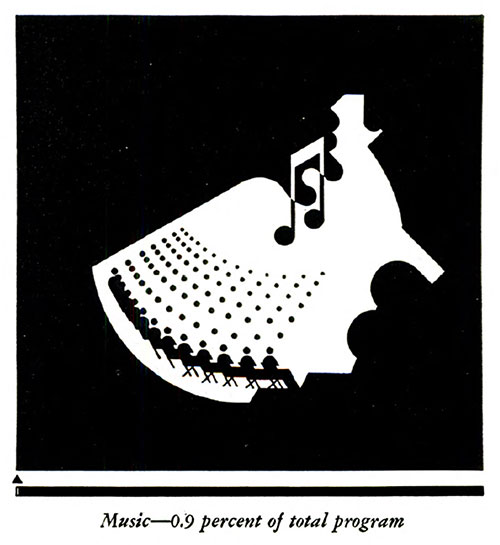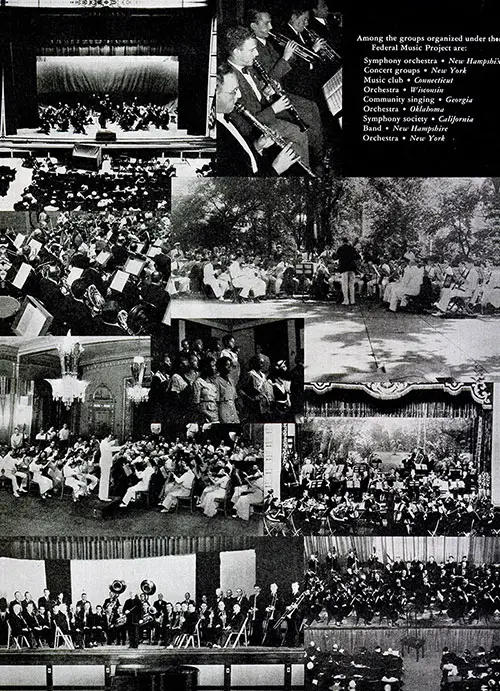WPA Federal Music Projects - 1938

Among the Groups Organized Under the WPA Federal Music Project are Orchestra (New York), Band (Kansas), Chorus (New York), Symphony Orchestra (Massachusetts), Tipica Orchestra (Texas), Band (Tennessee), Orchestra (Massachusetts). Inventory: An Appraisal of Results of the Works Progress Administration, Washington, DC: US Government Printing Office, 1938. GGA Image ID # 15269180bc
Through its Federal Music Project, the WPA has provided for millions of Americans the chance to hear living music, and given public work at their own craft to musicians and music teachers in 273 cities, towns, or counties in 42 States.

Music—0.9 Percent of Total Program. Inventory: An Appraisal of Results of the Works Progress Administration, Washington, DC: US Government Printing Office, 1938. GGA Image ID # 1526e79f52
This project, one of the few Federally operated activities of the WPA, was based upon the idea that professionals in the arts are among the most expensively trained of our people; and that their skill would be destroyed if they were put at other work.
The view of a metropolitan newspaper that "a good musician is as much a national resource as an oil well" may be held to be extreme; but plainly his best chance for a return to private employment lies in maintaining his musical skill.
At one time the Federal Music Project employed nearly 16,000 persons. It now employs about 10,000. The bulk of these musicians are organized into 40 symphony orchestras, about twice as many smaller concert orchestras, 69 bands, 52 dance orchestras, 30 opera and choral units, and a varied assortment of choruses and vocal groups.
They give on the average, more than 4,500 musical performances each month to an aver- age monthly attendance of over 3,100,000 persons, or more than 600 at each performance.
Thus total audiences aggregating in number more than half the population of the Nation have been able, during the life of the project, to hear the great symphonies, choral works, operas, operettas, madrigals, ballads, and folk songs, as played by living musicians.
Moreover, these opportunities have been open to all, since those performances which are not entirely free are available at the most nominal admission charges.
In order that performances of the larger units might be made available to suburban and rural areas which did not have such units of their own, transcribed programs have been presented by a large number of radio stations.
The hope behind this program is, of course, that wider public appreciation of good music will provide more private jobs for musicians; and this idea already is bearing fruit. Several small organizations have gone as units into private work.
Dr. Koussevitzky has taken eight project musicians for the Boston Sym- phony, the Pittsburgh Symphony has taken twelve. In fact, WPA musicians have been hired by every subscription symphony orchestra in the country except one.
In contrast, the cleverest members of Tin Pan Alley have cause to envy Michael Edwards, project worker in Pennsylvania, whose popular composition, "Once In Awhile," not only took him off the WPA, but banished his financial worries for some time to come.
In the teaching field, as many as 1,600 WPA music teachers have been employed, where regular personnel for such work has been notoriously inadequate. Average monthly attendance at such classes is in excess of 140,000, and many of the teachers have been absorbed into the regular school personnel.
The WPA's vast program of concerts and performances has provided great encouragement to American composers in the development of a native music.
Previously, young, and unknown composers experienced great difficulty in getting a hearing. But during the life of the Federal Music Project, 5,300 compositions by about 1,500 American composers have been given public performance, a scope and variety undreamed of in musical circles a few years ago.
Of the hundreds of comments on the work received from all sections of the country, that of Daniel Gregory Mason, MacDowell professor of music at Columbia University, is one of the most comprehensive:
"I have felt for some time a conviction that the WPA Federal Music Project is one of the best things that has ever happened to our native musical art. The wide diffusion of orchestras throughout our cities, the democratic standards in the selection and performance of music, the chance for American composers, the freedom from the need of sensationalism and the appeal to jaded, over-sophisticated tastes to which orchestras that have to watch the box-office too closely usually succumb—all these features make the WPA movement one of which the significance is not yet sufficiently appreciated, but which is nevertheless making history."
Charles Wakefield Cadman, the composer, has called it "the finest constructive force that ever has come into American musical life," and Mrs. Edward A. MacDowell finds it "a most valuable educational asset," while Erich W. Korngold, the Viennese composer, has declared that "nowhere in Europe is there anything that even compares with it."

Other Groups Organized Under the WPA Federal Music Project included Symphony Orchestra (New Hampshire), Concert Groups (New York), Music Club (Connecticut), Orchestra (Wisconsin), Community Singing (Georgia), Orchestra (Oklahoma), Symphony Society (California), Band (New Hampshire), Orchestra (New York). Inventory: An Appraisal of Results of the Works Progress Administration, Washington, DC: US Government Printing Office, 1938. GGA Image ID # 1526abac2b
"Music," in Inventory: An Appraisal of Results of the Works Progress Administration, Washington, DC: US Government Printing Office, 1938, pp. 71-74.

